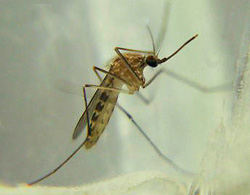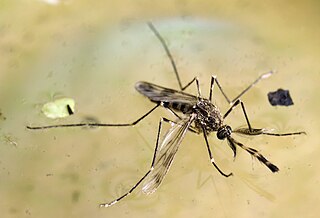Related Research Articles

Mosquitoes are members of a group of almost 3,600 species of small flies within the family Culicidae. The word "mosquito" is Spanish for "little fly". Mosquitoes have a slender segmented body, one pair of wings, one pair of halteres, three pairs of long hair-like legs, and elongated mouthparts.

Culex is a genus of mosquitoes, several species of which serve as vectors of one or more important diseases of birds, humans, and other animals. The diseases they vector include arbovirus infections such as West Nile virus, Japanese encephalitis, or St. Louis encephalitis, but also filariasis and avian malaria. They occur worldwide except for the extreme northern parts of the temperate zone, and are the most common form of mosquito encountered in some major U.S. cities, such as Los Angeles.

The discipline of medical entomology, or public health entomology, and also veterinary entomology is focused upon insects and arthropods that impact human health. Veterinary entomology is included in this category, because many animal diseases can "jump species" and become a human health threat, for example, bovine encephalitis. Medical entomology also includes scientific research on the behavior, ecology, and epidemiology of arthropod disease vectors, and involves a tremendous outreach to the public, including local and state officials and other stake holders in the interest of public safety.

The London Underground mosquito is a form of mosquito in the genus Culex. It is found in the London Underground railway system as its name suggests, but has a worldwide distribution and long predates the existence of the London Underground. It was first described as a distinct species from Egyptian specimens by the biologist Peter Forsskål (1732–1763). He named this mosquito Culex molestus due to its voracious biting, but later biologists renamed it Culex pipiens f. molestus because there were no morphological differences between it and Culex pipiens. Notably, this mosquito assaulted Londoners sleeping in the Underground during the Blitz, although similar populations were long known.

Culiseta is a genus of mosquitoes. Most Culiseta species are cold-adapted, and only occur in warmer climates during the colder parts of the year or at higher elevations where temperatures are lower. Species found in Southern California are larger than most mosquitoes species, specifically Cs. inornata, Cs. particeps, and Cs. incidens. These species are found throughout the year in Southern California and feed on several vertebrate species, such as birds, livestock, rodents, reptiles, and humans. The larvae of most species are found bogs, marshes, ponds, streams, ditches, and rock pools, but an African species occurs in tree holes ("phytotelmata"), a common eastern Palaearctic species occurs in water wells and rock pools, and several Australian species occur under ground. Little is known about the blood-feeding habits of females. Most species feed on birds and mammals, but a few feed on reptiles. Several species attack domestic animals and occasionally humans, and some species are pollinators.

Culex pipiens, commonly referred to as the common house mosquito, is a species of mosquito. House mosquitoes are some of the most common mosquitoes in the United States. More specifically, Culex pipiens is considered as the northern house mosquito, as it is the most common mosquito to the northern regions of the US. North of the 39th parallel north in the US, only C. pipiens are present, whereas south of the 36th parallel north, only C. quinquefasciatus are present. Additionally, they can be found in both urban and suburban temperate and tropical regions across the world.

Culex restuans is a species of mosquito known to occur in Canada, the United States, Mexico, Guatemala, and Honduras. It is a disease vector for St. Louis encephalitis and West Nile virus. In 2013 West Nile Virus positive specimens were collected in Southern California.

Aedes vexans, the inland floodwater mosquito or tomguito, is a cosmopolitan and common pest mosquito. This species has been collected in southern California.

Culex tarsalis, also known as Western Encephalitis Mosquito, is a mosquito species that appears in southern California. The species has black and white banding on the legs.

Culex quinquefasciatus, commonly known as the southern house mosquito, is a medium-sized mosquito found in tropical and subtropical regions of the world. It is a vector of Wuchereria bancrofti, avian malaria, and arboviruses including St. Louis encephalitis virus, Western equine encephalitis virus, Zika virus and West Nile virus. It is taxonomically regarded as a member of the Culex pipiens species complex. Its genome was sequenced in 2010, and was shown to have 18,883 protein-coding genes.
Alexander S. Raikhel is a distinguished professor of entomology at the University of California, Riverside, and an elected member of the United States National Academy of Sciences.

Culex nigripalpus is a species of medium-sized, dark, blood-feeding mosquito of the family Culicidae.

Anopheles freeborni, commonly known as the western malaria mosquito, is a species of mosquito in the family Culicidae. It is typically found in the western United States and Canada. Adults are brown to black, with yellow-brown hairs and gray-brown stripes on the thorax. Their scaly wings have four dark spots, which are less distinct in the male.

Culiseta incidens, the cool weather mosquito, is a species of mosquito in the family Culicidae. Specimens have been collected in Southern California.

Culiseta inornata, the winter marsh mosquito, or the Unadorned American Cool Weather Mosquito is a species of mosquito in the family Culicidae. This species is found in southern California.

Anopheles franciscanus is a species of mosquito in the family Culicidae. This species has been collected in southern California.
Culex stigmatasoma is a mosquito species that appears in Southern California, Oregon, and Texas. It is a confirmed vector of West Nile virus.
Culex thriambus is a mosquito species that appears in the southwestern United States, including Southern California, Texas, as well as in Mexico. It is a confirmed vector of West Nile virus. The majority of host species the mosquito takes blood from are in the order Passeriformes.
Culiseta particeps is a species of mosquito in the family Culicidae. It is found along the West coast of the United States including Southern California, Arizona as well as Mexico and Guatemala. Cs. particeps is not a known vector of human pathogens.
Anopheles hermsi is a species of mosquito in the family Culicidae. It is a known vector of Plasmodium vivax malaria. An. hermsi have been collected in Southern California.
References
- ↑ "Culex erythrothorax". Encyclopedia of Life. Retrieved 11 May 2015.
- ↑ Sandhu TS, Williams GW, Haynes BW, Dhillon MS. Population dynamics of blood-fed female mosquitoes and comparative efficacy of resting boxes in collecting them from the northwestern part of Riverside County, California. J Global Infect Dis [serial online] 2013 [cited 2013 Oct 22];5:15-8.
- ↑ Sandhu TS, Williams GA, Haynes BW, Dhillon MS. Evaluation of arboviral activity at Northwest Mosquito and Vector Control District, Riverside County, California during 2008. Proc and Papers of the Mosq and Vector Control Assoc of Calif, vol 77, 2009. p. 108-15.